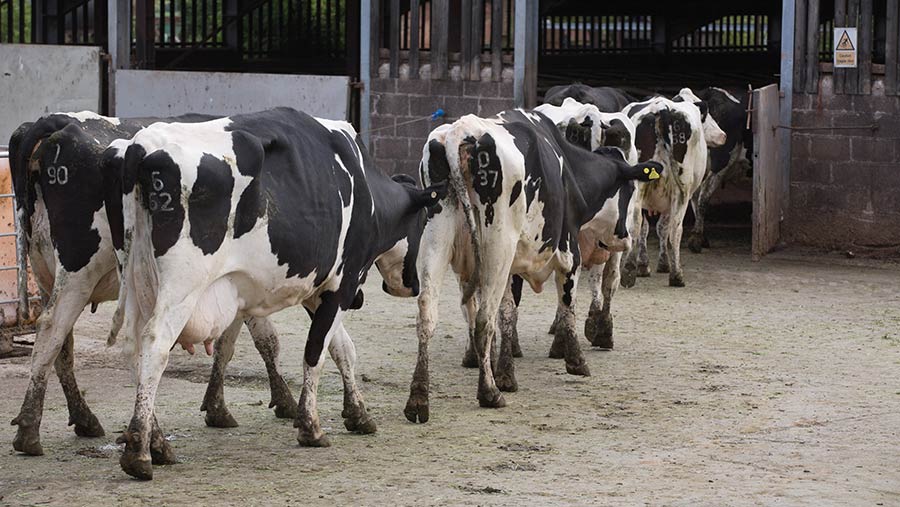4 ways to improve dairy milking routines
 © Tim Scrivener
© Tim Scrivener Good routines will set up milking for success in the key areas of hygiene, mastitis detection, herd throughput and, arguably the most important, milk flow rates.
Together they will improve the experience for the cows and the milking team.
See also: 5 ways to build on improvements in udder health
1. Milking routine
The milking routine is the foundation of all milking performance.
A successful milking routine starts before the cows even get near the milking parlour. Fetching cows sets the tone for the rest of the milking.
If we rush cows, or stress them in any way, they will be slower walking to the collecting area, less willing to enter the parlour, and milk let-down will be compromised.
Top tips for stress-free droving
- Leave plenty of time for fetching – allowing an extra 10 minutes for collecting can save 30 minutes in milking time
- Combine fetching cows with other jobs. Cleaning cubicles or moving fence wire is a good way of stopping us from getting impatient and pushing cows too hard
- Zigzag left and right behind cows to move them forward. Standing directly behind cows puts us in their blind spot, causing them to turn and check where we are, slowing down forward progress
- Work with the natural flight zones to increase cow walking speed. For example, if we walk against the intended direction of travel, the line of cows speeds up.
2. Understanding cow behaviour
Understanding cows’ natural behaviour helps improve their flow through the collecting yard and into the parlour.
This increases throughput and keeps cows calm, improving milk flow rates. Cows walk in a particular order, with lead cows and follower cows.
However, this is different from the order they like to be milked in, so cows need space to “reshuffle” once they reach the collecting yard.
We need to keep cows facing forward so they move in the right direction, and avoid face-to-face confrontations between the animals.
For best results in the collecting yard
- Allow space for cows to move freely within the collecting yard – 1.5sq m a cow for grazing cross-breds, or 1.8sq m a cow for larger breeds such as Holsteins
- Angle entry approaches to keep cows facing forward – cows meeting head-on cause traffic jams
- Avoid entering the collecting yard from the parlour. Emerging in front of the cows causes them to draw back and turn around
- Don’t use the backing gate to try to push the group forward. This is not effective and reduces milk let-down by increasing stress levels.
3. Milk flow
Maximising milk flow from the udder is crucial, not just for milking speed, but also for teat health.
Good milk flow mitigates other potentially negative impacts from machines by reducing the time the milking unit is attached to the cow. It also helps optimise the forces that the teats are exposed to.
Requirements for good milk flow
- Calm cows – eliminate stress from 30 minutes before milking
- Stimulation of the teat – physical contact of the teat skin is essential for milk let-down. Cows running their milk should not be confused with milk let-down – they are two separate things
- An appropriate delay between teat stimulation and unit attachment. This will vary for each herd based on yield and milking interval. Too short a delay will give a gap in milk flow at the start of milking. Too long will give a long milk-out period
- Optimum machine and liner settings – minimising teat oedema (swelling) reduces resistance to flow through the teat canal
- Consistency – cows are creatures of habit. A good routine half of the time will give less than half the benefit of doing it right all the time.
4. Parlour routine
The parlour routine itself has a big impact on milk let-down and cow throughput. Stress-free loading gives both better cow flow and better milk flow.
The order in which tasks are completed and the way the parlour is used can give big time savings.
To optimise parlour routine
- Work out what preparation is necessary. This will depend on the level of teat contamination
- Remember that not stimulating teats will lead to poor milk let-down
- In linear parlours, allow cows to enter/exit while you are working on the opposite row, whenever possible. This is a more efficient use of milking staff time and less stressful for the cows
- In linear parlours, prepare cows from the front of the parlour to the back. This means we don’t need to wait for the whole row to load before starting
- Adopt a routine that gives the optimum time lag between preparation and attachment
- Use available staff to ensure the shortest possible time to attach the last unit of the row – a common rate-limiting step
- For rotary parlours, fix the turn speed as high as the units can comfortably be attached. Then work back from this to give appropriate gaps between preparation and attachment
- Avoid encouraging cows to exit by whistling/clapping/tapping the metalwork. This is effective at sending cows out of the parlour, but equally effective at discouraging waiting cows from coming in.

